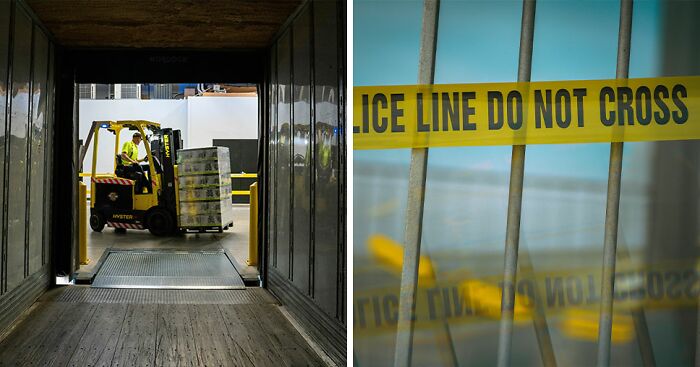
Graphic Designers Show What 6 Asian Castles Looked Like Before Falling Into Ruins
You are surely craving traveling by this point, so the best we can do is to offer you a way to discover something new and exciting without leaving your home. This time it’s the largest and the most populated continent, Asia, with its 45 million square kilometers of deserts, mountains, plateaus, plains, and jungles that carry the history of ancient civilizations. Budget Direct decided to digitally reconstruct 6 castles that have turned into ruins over the years across five countries in Asia. Asia’s architectural wonders are restored to their former glory right before our eyes.
This is the latest project in the series of reconstructions by Budget Direct: the team has previously brought back to life European castles, Ancient Wonders, and heritage sites protected by UNESCO.
Lee McCullagh, one of the project’s editors, spoke to Bored Panda:
“2020 saw millions of people across the globe are stuck at home, and even in 2021, there are many travel restrictions still in place. To support those searching for armchair travel inspiration, Budget Direct decided to bring back some of the most awe-inspiring castles from across Asia. The team started by making a long list of castles in Asia and then narrowed these down to those that had available resources for us to digitally remaster.
They then chose the castles with the most architectural wonder from across the continent to rebuild. The team worked with researchers, architects, and digital designers to bring these ancient castles into the 21st century.”
So sit back, relax, and let the virtual travel begin! And hopefully, you’ll find out something new today along the way.
More info: budgetdirect.com.au
Alamut Castle, Alamut Valley, Iran
Image credits: budgetdirect
Image credits: budgetdirect
In 1090, Imam Hassan-i Sabbāh supposedly conquered the castle without shedding a drop of blood. The new state secured its power with targeted attacks on enemy leaders. Those who perpetrated these attacks were derogatorily referred to as “Hashashin” (“riotous herbage”), thus giving birth to the word “Assassin.” Ironically, Alamut’s fame led to its demise; its various conquerors demolished the castle as they searched for legendary assassin treasure.
Alamut Rock is a popular day hike which offers an eagle-eyed view of the surrounding country. However, not much remains of Alamut castle itself; its few surviving stone nubs are covered in scaffolding while the Iranian government attempts to partially restore it for tourists.
Image credits: budgetdirect
The Old Summer Palace, Beijing, China
Image credits: budgetdirect
Image credits: budgetdirect
The Yuanming Yuan—known in the Western World as the Old Summer Palace—was not a single building but a 3.5 square kilometer complex of palaces, lakes, gardens, towers, and sculptures. The pride of the Qing Dynasty, Yuanming Yuan, was largely destroyed by British and French forces in retaliation for the death of a British envoy during the Second Opium War. Further destruction occurred during the Boxer Rebellion and the Cultural Revolution.
We have chosen here to reconstruct the Yuanming Yuan’s Haiyantang (The Palace of Calm Seas). In front of a two-story western-style palace, a water clock was surrounded by the 12 animals of the Chinese Zodiac. Today, the seashell centerpiece of the fountain sits inside the outline of its former depression, backed by a gap-toothed vista of tumbled palace columns.
Image credits: budgetdirect
Hagi Castle, Hagi, Japan
Image credits: budgetdirect
Image credits: budgetdirect
The Mōri Samurai clan lost to Tokugawa in the Battle of Sekigahara, and as a result, had to rebuild their capital in the small seaside city of Hagi. The Mōri got their revenge, however. The castle became the capital of the Chōshū Domain, which was instrumental in the eventual overthrow of the Tokugawa Shogunate. Ironically, the castle was dismantled by the new government in 1874 as part of a policy of centralization and modernization.
Hagi was quite formidable in its day. Multiple baileys and walls protect the surrounding land, many of which still can be seen. The main wooden keep was dismantled, but its stone base and part of its moat endure. Higher up the mountain, the remains of a fallback keep can be found.
Image credits: budgetdirect
Citadel of Ghazni, Ghazni, Afghanistan
Image credits: budgetdirect
Image credits: budgetdirect
The former slave Sebüktigin was granted the governorship of Ghazni in 977, but he promptly rebelled against his ruling Iranian overlords to found the Ghazni Empire. Ghazni became the military linchpin of Afghanistan, sought after by history’s VIP conquerors from Timur (Tamerlane) to the Mongols. When the citadel was famously conquered by the British in 1839, Afghani leadership was required to flee Kabul. It was also used as a military base by America after 2001.
The remains of the citadel perch atop a central hill overlooking the walled city. However, neglect, war, and weather have heavily damaged Ghazni. 14 of its original 32 towers have collapsed, one as recently as 2019. Today, Ghazni’s walls, towers, and citadel are in danger of being lost to the winds of time for good.
Image credits: budgetdirect
Raigad Fort, Raigad, Maharashtra, India
Image credits: budgetdirect
Image credits: budgetdirect
Though parts of the structure date back to 1030 AD, Raigad’s already impressive fortifications were expanded by Shivaji Maharaj. Shivaji was crowned Chhatrapati (“Umbrella Lord”) here in 1674, establishing the Maratha Confederacy in opposition to the Mughal Empire. The Confederacy would control Raigad until its destruction at the hands of the British East India Company in 1818.
The main entrance to the castle is 820 meters above sea level—a climb of 1737 steps. (Fortunately, there is now an aerial tramway.) Visitors can still view the remains of two of the three watchtowers, several reservoirs, stone merchant stalls, and a famous wall named Hirakani Buruj.
Image credits: budgetdirect
Takeda Castle, Asago, Hyōgo, Japan
Image credits: budgetdirect
Image credits: budgetdirect
Takeda was built in the 15th century by “the Red Monk”— a man partially responsible for plunging Japan into the century of chaos known as the Sengoku period. The fortress was eventually conquered by Toyotomi Hideyoshi during reunification. After Hideyoshi’s death, the new Shogun Tokugawa Ieyasu accused the castle’s final lord of arson during a pivotal battle. From here, Takeda fell into disrepair.
Today, the ruins of the castle sit 353 meters above sea level. Though no buildings are left standing on the mountain itself, a row of temples has survived by the base. The stone foundations of the castle are well-kept, having undergone minor restorations in the late 20th century. Because of a seasonal fog that fills the valley, some mornings Takeda appears to float above the clouds.
Image credits: budgetdirect
142Kviews
Share on FacebookExplore more of these tags
It’s also a brilliantly constructed stronghold. You could hold off an army 12x the defending size. Note how the ramps always have areas above them to shoot arrows/dump pitch or oil/throw rocks. And note how they spiral clockwise. The typical right handed solider would have to expose their entire body to a right handed defender to bring their sword into play, while the defender only needs to use their right arm while keeping the rest of their body concealed around the curve. The rock that it’s built on would be nearly impossible to scale from the rear, and I assume the stronghold at the top, should all else fail, is nigh on impenetrable.
Load More Replies...it's interesting how some of these ruins are completely disappeared, but others still have a skeleton- would be interesting to see a timeline of these castles!
It’s also a brilliantly constructed stronghold. You could hold off an army 12x the defending size. Note how the ramps always have areas above them to shoot arrows/dump pitch or oil/throw rocks. And note how they spiral clockwise. The typical right handed solider would have to expose their entire body to a right handed defender to bring their sword into play, while the defender only needs to use their right arm while keeping the rest of their body concealed around the curve. The rock that it’s built on would be nearly impossible to scale from the rear, and I assume the stronghold at the top, should all else fail, is nigh on impenetrable.
Load More Replies...it's interesting how some of these ruins are completely disappeared, but others still have a skeleton- would be interesting to see a timeline of these castles!

 Dark Mode
Dark Mode 

 No fees, cancel anytime
No fees, cancel anytime 




































































310
33